Assignment Multiple Choice Question and Answer Physics
VerifiedAdded on 2022/09/12
|7
|1096
|19
Assignment
AI Summary
Contribute Materials
Your contribution can guide someone’s learning journey. Share your
documents today.
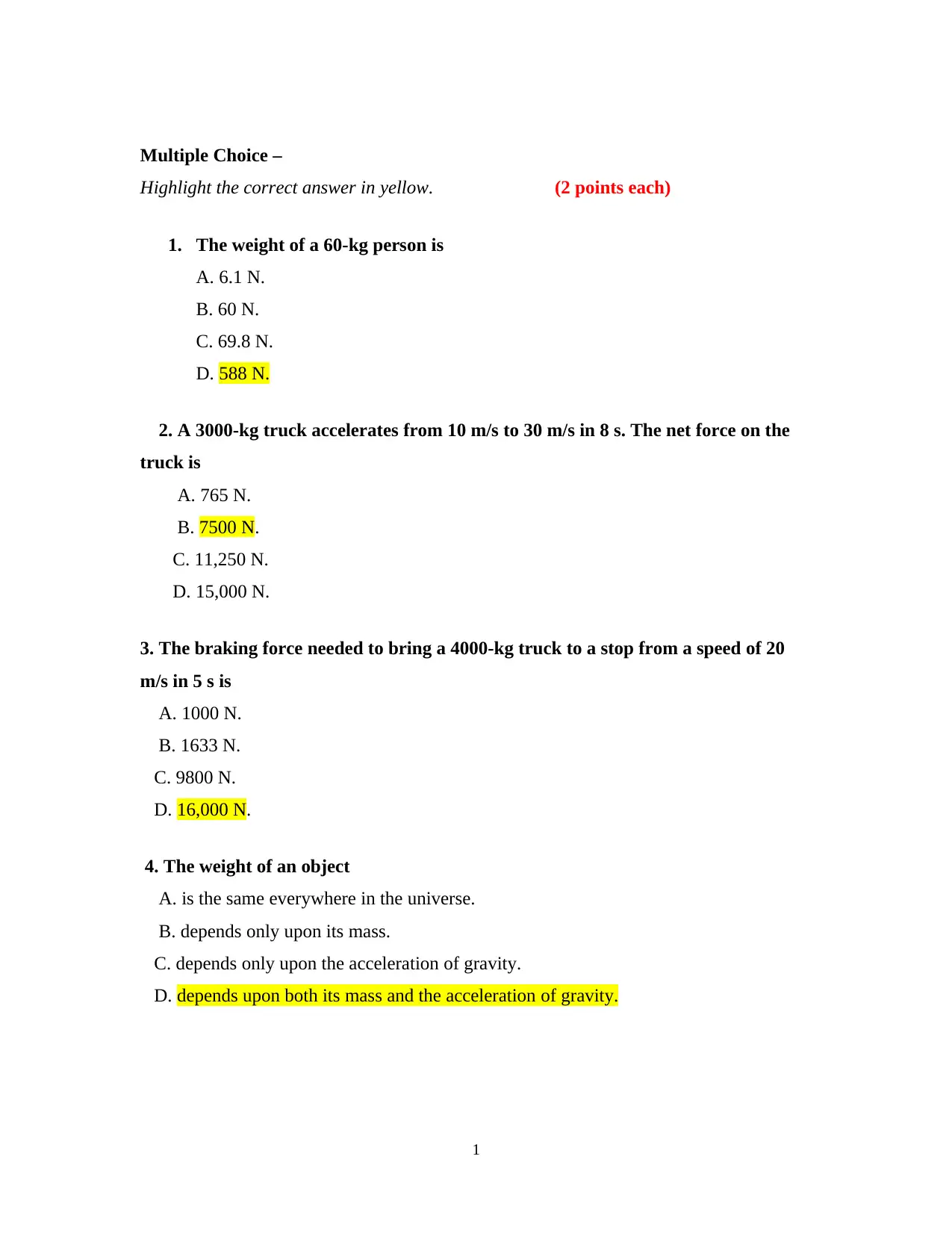
Multiple Choice –
Highlight the correct answer in yellow. (2 points each)
1. The weight of a 60-kg person is
A. 6.1 N.
B. 60 N.
C. 69.8 N.
D. 588 N.
2. A 3000-kg truck accelerates from 10 m/s to 30 m/s in 8 s. The net force on the
truck is
A. 765 N.
B. 7500 N.
C. 11,250 N.
D. 15,000 N.
3. The braking force needed to bring a 4000-kg truck to a stop from a speed of 20
m/s in 5 s is
A. 1000 N.
B. 1633 N.
C. 9800 N.
D. 16,000 N.
4. The weight of an object
A. is the same everywhere in the universe.
B. depends only upon its mass.
C. depends only upon the acceleration of gravity.
D. depends upon both its mass and the acceleration of gravity.
1
Highlight the correct answer in yellow. (2 points each)
1. The weight of a 60-kg person is
A. 6.1 N.
B. 60 N.
C. 69.8 N.
D. 588 N.
2. A 3000-kg truck accelerates from 10 m/s to 30 m/s in 8 s. The net force on the
truck is
A. 765 N.
B. 7500 N.
C. 11,250 N.
D. 15,000 N.
3. The braking force needed to bring a 4000-kg truck to a stop from a speed of 20
m/s in 5 s is
A. 1000 N.
B. 1633 N.
C. 9800 N.
D. 16,000 N.
4. The weight of an object
A. is the same everywhere in the universe.
B. depends only upon its mass.
C. depends only upon the acceleration of gravity.
D. depends upon both its mass and the acceleration of gravity.
1
Secure Best Marks with AI Grader
Need help grading? Try our AI Grader for instant feedback on your assignments.
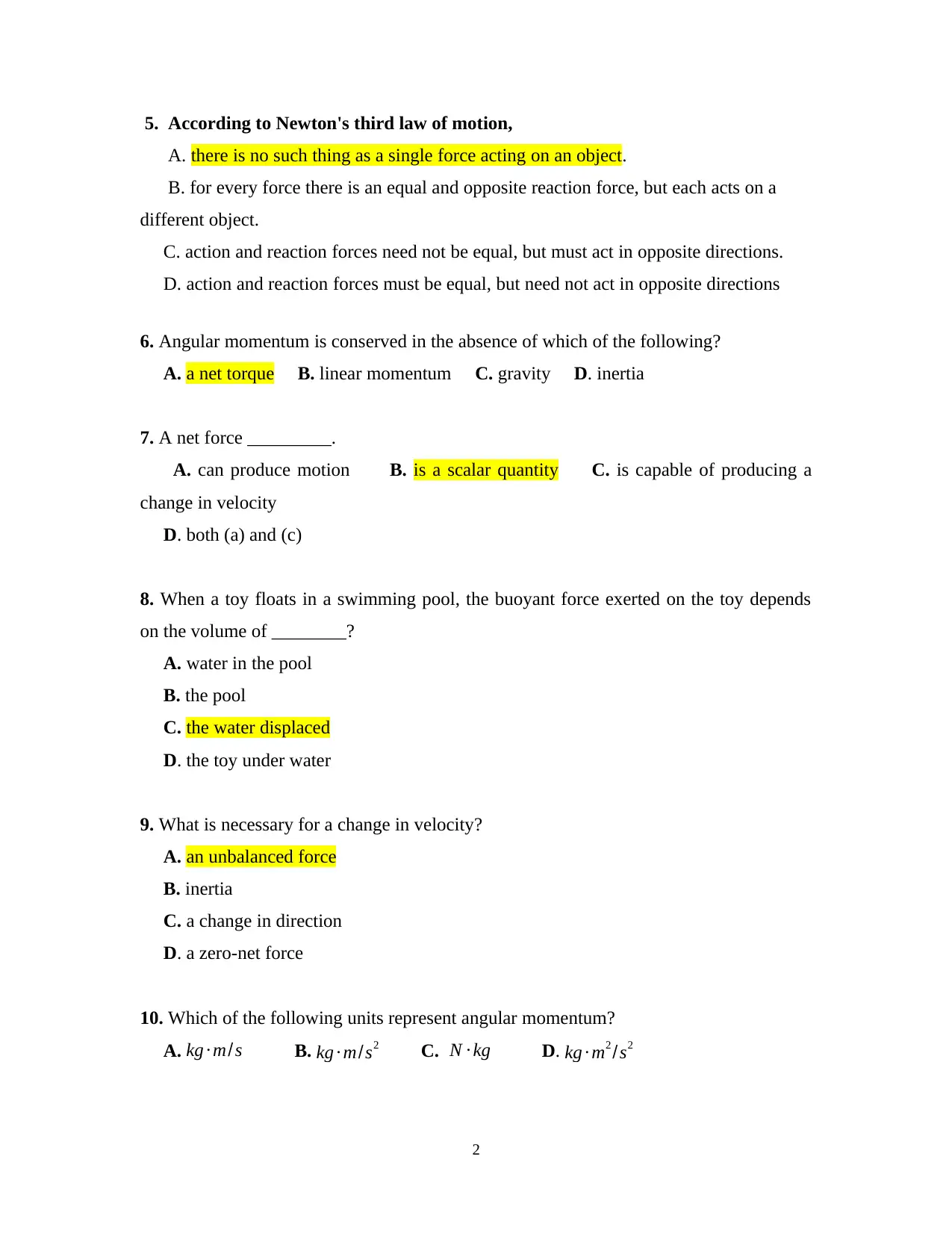
5. According to Newton's third law of motion,
A. there is no such thing as a single force acting on an object.
B. for every force there is an equal and opposite reaction force, but each acts on a
different object.
C. action and reaction forces need not be equal, but must act in opposite directions.
D. action and reaction forces must be equal, but need not act in opposite directions
6. Angular momentum is conserved in the absence of which of the following?
A. a net torque B. linear momentum C. gravity D. inertia
7. A net force _________.
A. can produce motion B. is a scalar quantity C. is capable of producing a
change in velocity
D. both (a) and (c)
8. When a toy floats in a swimming pool, the buoyant force exerted on the toy depends
on the volume of ________?
A. water in the pool
B. the pool
C. the water displaced
D. the toy under water
9. What is necessary for a change in velocity?
A. an unbalanced force
B. inertia
C. a change in direction
D. a zero-net force
10. Which of the following units represent angular momentum?
A. kg ∙ m/s B. kg ∙ m/s2 C. N ∙ kg D. kg ∙ m2 /s2
2
A. there is no such thing as a single force acting on an object.
B. for every force there is an equal and opposite reaction force, but each acts on a
different object.
C. action and reaction forces need not be equal, but must act in opposite directions.
D. action and reaction forces must be equal, but need not act in opposite directions
6. Angular momentum is conserved in the absence of which of the following?
A. a net torque B. linear momentum C. gravity D. inertia
7. A net force _________.
A. can produce motion B. is a scalar quantity C. is capable of producing a
change in velocity
D. both (a) and (c)
8. When a toy floats in a swimming pool, the buoyant force exerted on the toy depends
on the volume of ________?
A. water in the pool
B. the pool
C. the water displaced
D. the toy under water
9. What is necessary for a change in velocity?
A. an unbalanced force
B. inertia
C. a change in direction
D. a zero-net force
10. Which of the following units represent angular momentum?
A. kg ∙ m/s B. kg ∙ m/s2 C. N ∙ kg D. kg ∙ m2 /s2
2
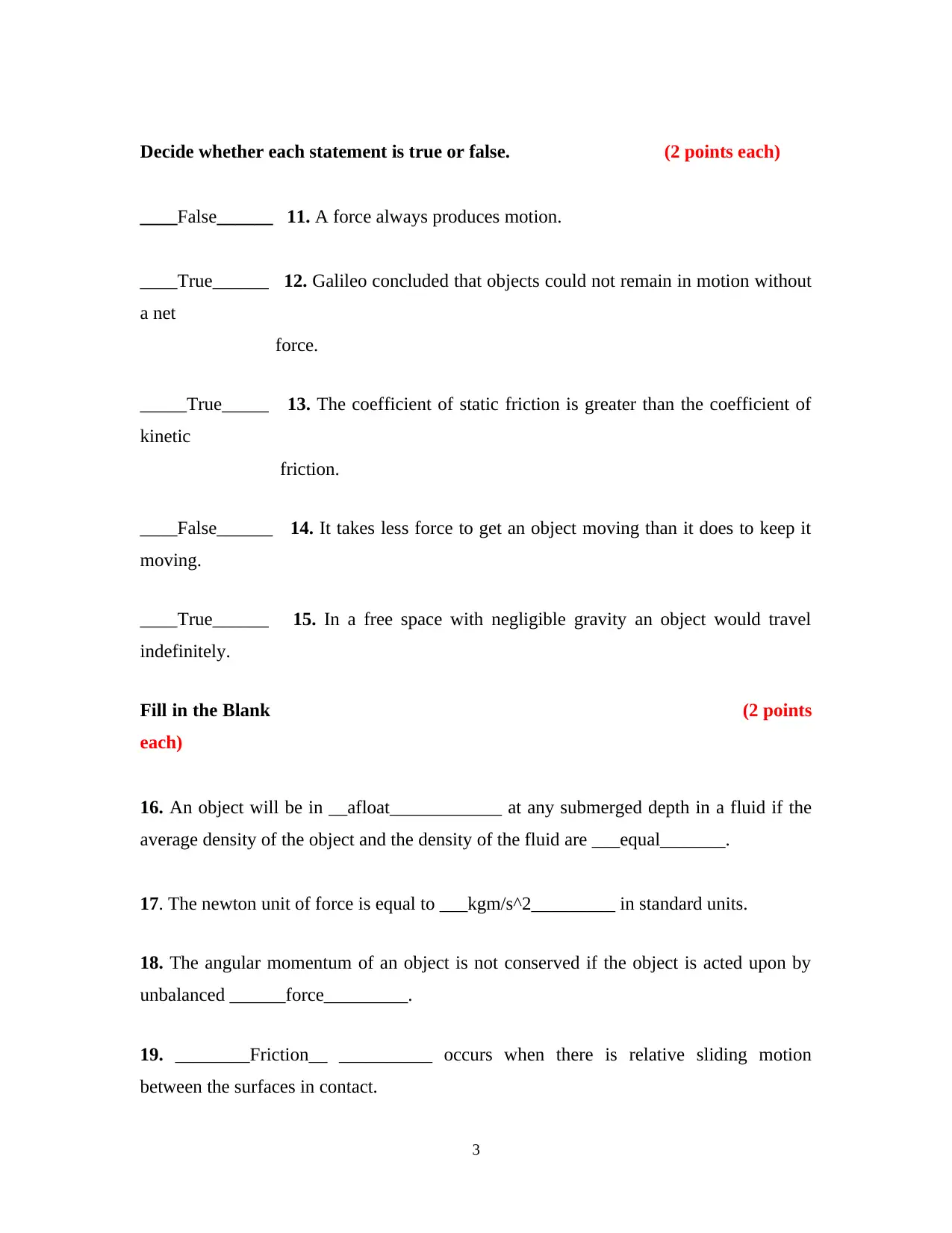
Decide whether each statement is true or false. (2 points each)
____False______ 11. A force always produces motion.
____True______ 12. Galileo concluded that objects could not remain in motion without
a net
force.
_____True_____ 13. The coefficient of static friction is greater than the coefficient of
kinetic
friction.
____False______ 14. It takes less force to get an object moving than it does to keep it
moving.
____True______ 15. In a free space with negligible gravity an object would travel
indefinitely.
Fill in the Blank (2 points
each)
16. An object will be in __afloat____________ at any submerged depth in a fluid if the
average density of the object and the density of the fluid are ___equal_______.
17. The newton unit of force is equal to ___kgm/s^2_________ in standard units.
18. The angular momentum of an object is not conserved if the object is acted upon by
unbalanced ______force_________.
19. ________Friction__ __________ occurs when there is relative sliding motion
between the surfaces in contact.
3
____False______ 11. A force always produces motion.
____True______ 12. Galileo concluded that objects could not remain in motion without
a net
force.
_____True_____ 13. The coefficient of static friction is greater than the coefficient of
kinetic
friction.
____False______ 14. It takes less force to get an object moving than it does to keep it
moving.
____True______ 15. In a free space with negligible gravity an object would travel
indefinitely.
Fill in the Blank (2 points
each)
16. An object will be in __afloat____________ at any submerged depth in a fluid if the
average density of the object and the density of the fluid are ___equal_______.
17. The newton unit of force is equal to ___kgm/s^2_________ in standard units.
18. The angular momentum of an object is not conserved if the object is acted upon by
unbalanced ______force_________.
19. ________Friction__ __________ occurs when there is relative sliding motion
between the surfaces in contact.
3
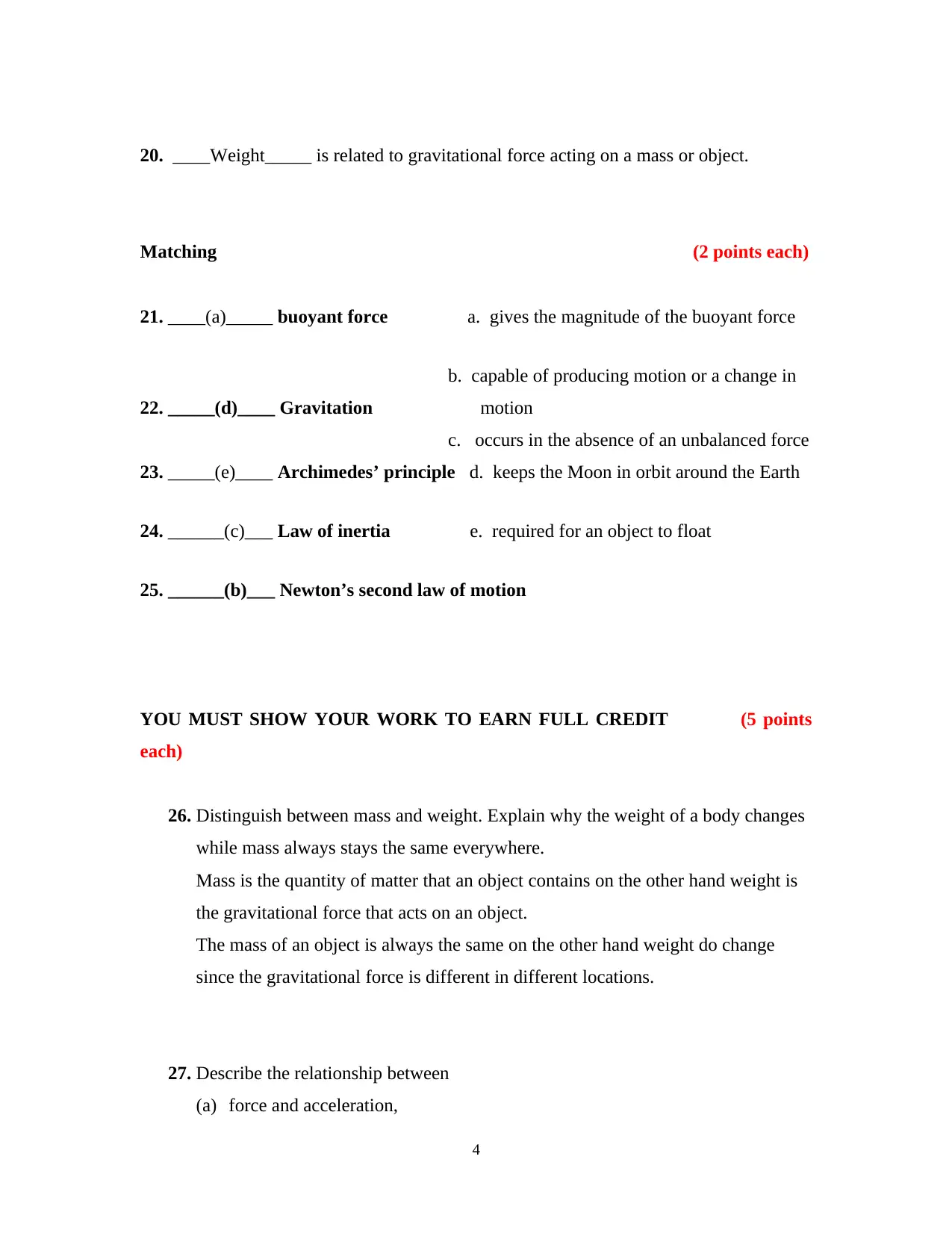
20. ____Weight_____ is related to gravitational force acting on a mass or object.
Matching (2 points each)
21. ____(a)_____ buoyant force a. gives the magnitude of the buoyant force
b. capable of producing motion or a change in
22. _____(d)____ Gravitation motion
c. occurs in the absence of an unbalanced force
23. _____(e)____ Archimedes’ principle d. keeps the Moon in orbit around the Earth
24. ______(c)___ Law of inertia e. required for an object to float
25. ______(b)___ Newton’s second law of motion
YOU MUST SHOW YOUR WORK TO EARN FULL CREDIT (5 points
each)
26. Distinguish between mass and weight. Explain why the weight of a body changes
while mass always stays the same everywhere.
Mass is the quantity of matter that an object contains on the other hand weight is
the gravitational force that acts on an object.
The mass of an object is always the same on the other hand weight do change
since the gravitational force is different in different locations.
27. Describe the relationship between
(a) force and acceleration,
4
Matching (2 points each)
21. ____(a)_____ buoyant force a. gives the magnitude of the buoyant force
b. capable of producing motion or a change in
22. _____(d)____ Gravitation motion
c. occurs in the absence of an unbalanced force
23. _____(e)____ Archimedes’ principle d. keeps the Moon in orbit around the Earth
24. ______(c)___ Law of inertia e. required for an object to float
25. ______(b)___ Newton’s second law of motion
YOU MUST SHOW YOUR WORK TO EARN FULL CREDIT (5 points
each)
26. Distinguish between mass and weight. Explain why the weight of a body changes
while mass always stays the same everywhere.
Mass is the quantity of matter that an object contains on the other hand weight is
the gravitational force that acts on an object.
The mass of an object is always the same on the other hand weight do change
since the gravitational force is different in different locations.
27. Describe the relationship between
(a) force and acceleration,
4
Secure Best Marks with AI Grader
Need help grading? Try our AI Grader for instant feedback on your assignments.
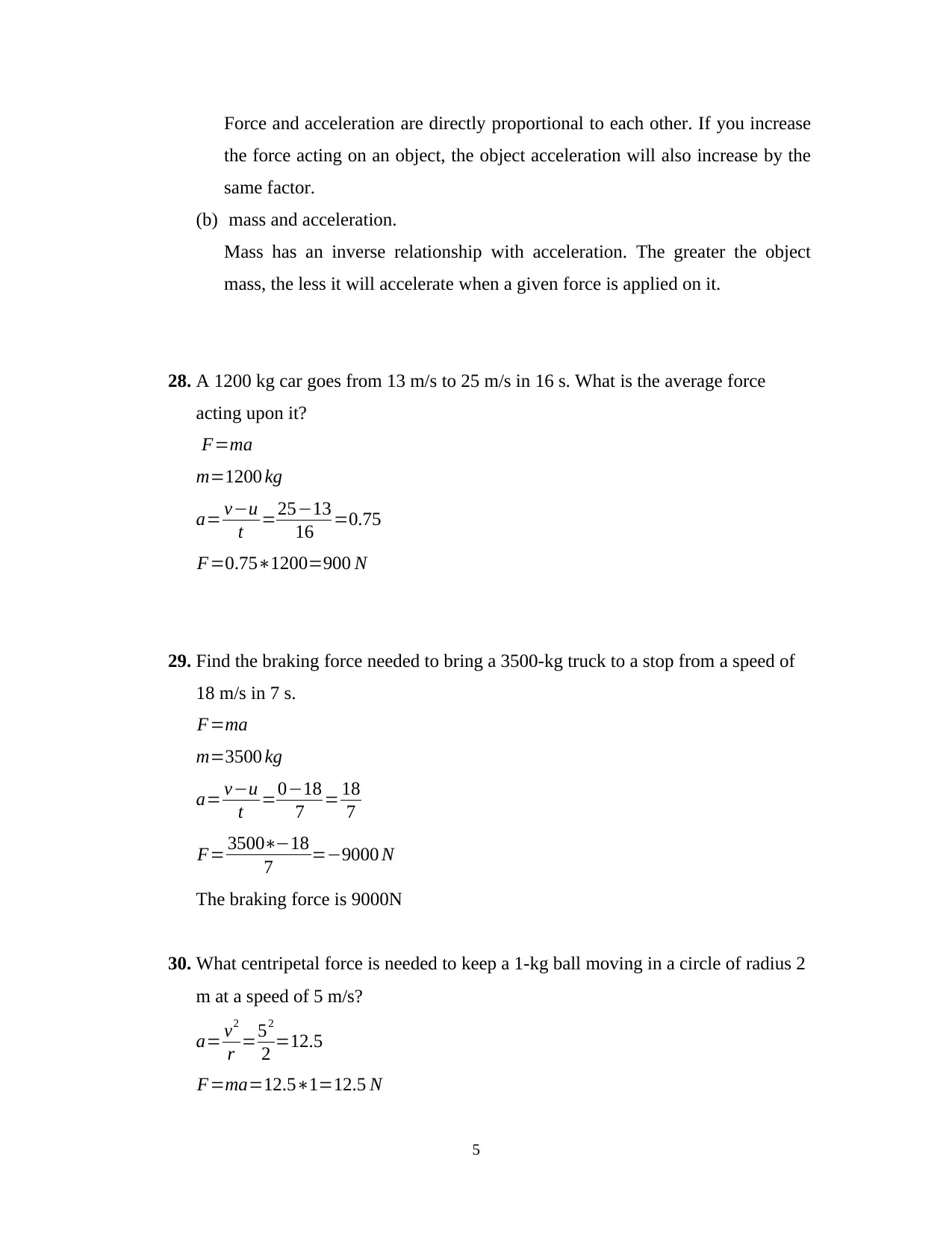
Force and acceleration are directly proportional to each other. If you increase
the force acting on an object, the object acceleration will also increase by the
same factor.
(b) mass and acceleration.
Mass has an inverse relationship with acceleration. The greater the object
mass, the less it will accelerate when a given force is applied on it.
28. A 1200 kg car goes from 13 m/s to 25 m/s in 16 s. What is the average force
acting upon it?
F=ma
m=1200 kg
a= v−u
t =25−13
16 =0.75
F=0.75∗1200=900 N
29. Find the braking force needed to bring a 3500-kg truck to a stop from a speed of
18 m/s in 7 s.
F=ma
m=3500 kg
a= v−u
t =0−18
7 = 18
7
F= 3500∗−18
7 =−9000 N
The braking force is 9000N
30. What centripetal force is needed to keep a 1-kg ball moving in a circle of radius 2
m at a speed of 5 m/s?
a= v2
r =52
2 =12.5
F=ma=12.5∗1=12.5 N
5
the force acting on an object, the object acceleration will also increase by the
same factor.
(b) mass and acceleration.
Mass has an inverse relationship with acceleration. The greater the object
mass, the less it will accelerate when a given force is applied on it.
28. A 1200 kg car goes from 13 m/s to 25 m/s in 16 s. What is the average force
acting upon it?
F=ma
m=1200 kg
a= v−u
t =25−13
16 =0.75
F=0.75∗1200=900 N
29. Find the braking force needed to bring a 3500-kg truck to a stop from a speed of
18 m/s in 7 s.
F=ma
m=3500 kg
a= v−u
t =0−18
7 = 18
7
F= 3500∗−18
7 =−9000 N
The braking force is 9000N
30. What centripetal force is needed to keep a 1-kg ball moving in a circle of radius 2
m at a speed of 5 m/s?
a= v2
r =52
2 =12.5
F=ma=12.5∗1=12.5 N
5
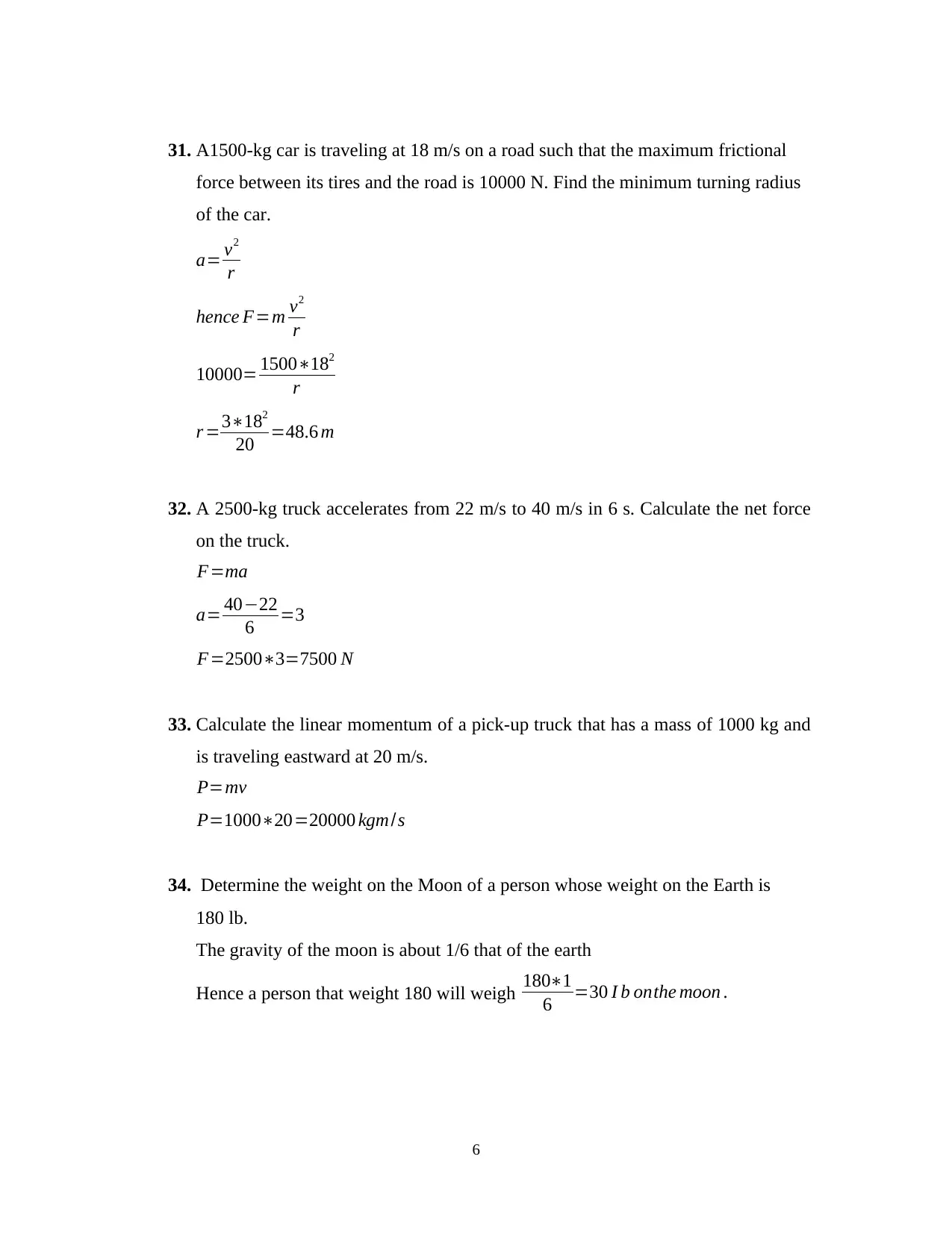
31. A1500-kg car is traveling at 18 m/s on a road such that the maximum frictional
force between its tires and the road is 10000 N. Find the minimum turning radius
of the car.
a= v2
r
hence F=m v2
r
10000= 1500∗182
r
r =3∗182
20 =48.6 m
32. A 2500-kg truck accelerates from 22 m/s to 40 m/s in 6 s. Calculate the net force
on the truck.
F=ma
a= 40−22
6 =3
F=2500∗3=7500 N
33. Calculate the linear momentum of a pick-up truck that has a mass of 1000 kg and
is traveling eastward at 20 m/s.
P=mv
P=1000∗20=20000 kgm /s
34. Determine the weight on the Moon of a person whose weight on the Earth is
180 lb.
The gravity of the moon is about 1/6 that of the earth
Hence a person that weight 180 will weigh 180∗1
6 =30 I b onthe moon .
6
force between its tires and the road is 10000 N. Find the minimum turning radius
of the car.
a= v2
r
hence F=m v2
r
10000= 1500∗182
r
r =3∗182
20 =48.6 m
32. A 2500-kg truck accelerates from 22 m/s to 40 m/s in 6 s. Calculate the net force
on the truck.
F=ma
a= 40−22
6 =3
F=2500∗3=7500 N
33. Calculate the linear momentum of a pick-up truck that has a mass of 1000 kg and
is traveling eastward at 20 m/s.
P=mv
P=1000∗20=20000 kgm /s
34. Determine the weight on the Moon of a person whose weight on the Earth is
180 lb.
The gravity of the moon is about 1/6 that of the earth
Hence a person that weight 180 will weigh 180∗1
6 =30 I b onthe moon .
6
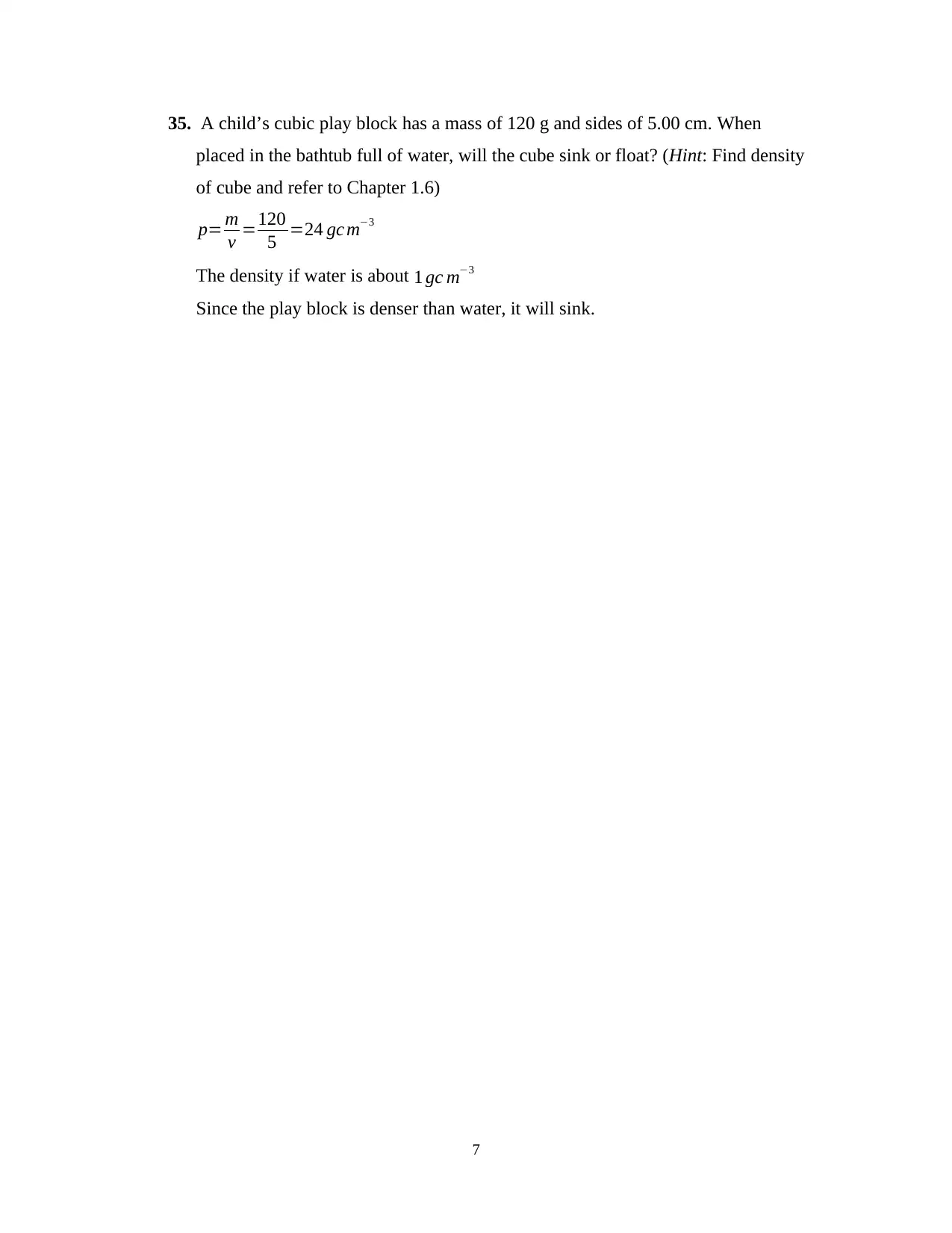
35. A child’s cubic play block has a mass of 120 g and sides of 5.00 cm. When
placed in the bathtub full of water, will the cube sink or float? (Hint: Find density
of cube and refer to Chapter 1.6)
p= m
v =120
5 =24 gc m−3
The density if water is about 1 gc m−3
Since the play block is denser than water, it will sink.
7
placed in the bathtub full of water, will the cube sink or float? (Hint: Find density
of cube and refer to Chapter 1.6)
p= m
v =120
5 =24 gc m−3
The density if water is about 1 gc m−3
Since the play block is denser than water, it will sink.
7
1 out of 7
Related Documents
Your All-in-One AI-Powered Toolkit for Academic Success.
+13062052269
info@desklib.com
Available 24*7 on WhatsApp / Email
![[object Object]](/_next/static/media/star-bottom.7253800d.svg)
Unlock your academic potential
© 2024 | Zucol Services PVT LTD | All rights reserved.





